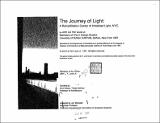| dc.contributor.advisor | Imre Halasz. | en_US |
| dc.contributor.author | Louie, John Lai Yen | en_US |
| dc.contributor.other | Massachusetts Institute of Technology. Dept. of Architecture. | en_US |
| dc.coverage.spatial | n-us-ny | en_US |
| dc.date.accessioned | 2012-01-12T18:33:44Z | |
| dc.date.available | 2012-01-12T18:33:44Z | |
| dc.date.copyright | 1991 | en_US |
| dc.date.issued | 1991 | en_US |
| dc.identifier.uri | http://hdl.handle.net/1721.1/68252 | |
| dc.description | Thesis (M. Arch.)--Massachusetts Institute of Technology, Dept. of Architecture, 1991. | en_US |
| dc.description | Includes bibliographical references (p. 112-114). | en_US |
| dc.description.abstract | The primary intention of this thesis is to explore the tectonic qualities of light throughCthe design of a building. In addition to addressing some of the more general questions concerning light raised in the design process, the design attempts to demonstrate how light can define a multiplicity of places and generate the physical architectural order of a building. The investigation of light is conducted through studies with the various physical and spatial components of the building. The primary goal of these explorations with light is to enrich a personal understanding of light in architectural terms for the purpose of design. In addition, the program of a drug rehabilitation center examines how the intangible qualities of light in a building can serve to inspire and contribute to the process of healing physically as well as emotionally. The significance of the program ensures that the studies with light are not just generic and formal, but recognizes that any formal understanding of light must be applied to broader ends in order for it to be meaningful. The thesis itself is organized in five chapters: -- Chapter One introduces the basic questions regarding light which prompted this design investigation. It specifies the intention and the scope of this thesis and discusses the method of the investigation. -- Chapter Two describes the context of the design. It reveals why an urban rehabilitation center was chosen for the design and points out the role of the program in the explorations with light. There is also a description of the site and a discussion of some of the most important advocacies which operated throughout the design process. -- Chapter Three presents the design through plans, sections, and vignettes of the building as a "Journey of Light." -- Chapter Four is a collection of some of the studies conducted during the design process. These studies are grouped under two sections. The first group includes the more analytically oriented studies which are based on observations connected to the city, the site and the room. The second section consists of the qualitative explorations with light and a list of the questions regarding light which these studies attempt to address. The latter group of studies are organized in terms of the volume, wall and frame of the building. -- Chapter Five summarizes the the most important lessons gained from this study and offers an assessment of the value of this investigation. | en_US |
| dc.description.statementofresponsibility | by John Lai Yen Louie, Jr. | en_US |
| dc.format.extent | 115 p. | en_US |
| dc.language.iso | eng | en_US |
| dc.publisher | Massachusetts Institute of Technology | en_US |
| dc.rights | M.I.T. theses are protected by
copyright. They may be viewed from this source for any purpose, but
reproduction or distribution in any format is prohibited without written
permission. See provided URL for inquiries about permission. | en_US |
| dc.rights.uri | http://dspace.mit.edu/handle/1721.1/7582 | en_US |
| dc.subject | Architecture. | en_US |
| dc.title | The journey of light : a rehabilitation center of inhabited light, NYC | en_US |
| dc.title.alternative | Rehabilitation center of inhabited light, NYC | en_US |
| dc.type | Thesis | en_US |
| dc.description.degree | M.Arch. | en_US |
| dc.contributor.department | Massachusetts Institute of Technology. Department of Architecture | |
| dc.identifier.oclc | 24960342 | en_US |
